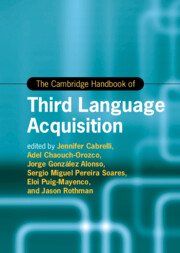Book contents
- The Cambridge Handbook of Third Language Acquisition
- Cambridge Handbooks in Language and Linguistics
- The Cambridge Handbook of Third Language Acquisition
- Copyright page
- Contents
- Figures
- Tables
- Contributors
- Introduction Multilingualism
- Part I Theoretical Approaches to L3/Ln
- Part II L3/Ln across Linguistic Domains
- Part III Becoming and Staying Multilingual at Different Ages
- 11 3L1 Acquisition
- 12 Multilingualism and Education
- 13 Language Attrition and L3/Ln
- 14 Heritage Speakers as L3 Acquirers
- 15 The Effects of Environment Change on Third Languages
- Part IV L3/Ln in Action
- Part V L3/Ln and Cognition
- Part VI Research Methods in L3/Ln
- Index
- References
12 - Multilingualism and Education
from Part III - Becoming and Staying Multilingual at Different Ages
Published online by Cambridge University Press: 13 July 2023
- The Cambridge Handbook of Third Language Acquisition
- Cambridge Handbooks in Language and Linguistics
- The Cambridge Handbook of Third Language Acquisition
- Copyright page
- Contents
- Figures
- Tables
- Contributors
- Introduction Multilingualism
- Part I Theoretical Approaches to L3/Ln
- Part II L3/Ln across Linguistic Domains
- Part III Becoming and Staying Multilingual at Different Ages
- 11 3L1 Acquisition
- 12 Multilingualism and Education
- 13 Language Attrition and L3/Ln
- 14 Heritage Speakers as L3 Acquirers
- 15 The Effects of Environment Change on Third Languages
- Part IV L3/Ln in Action
- Part V L3/Ln and Cognition
- Part VI Research Methods in L3/Ln
- Index
- References
Summary
Multilingualism in education consists in the teaching and learning of local majority languages, together with languages with an international status and new minority languages. Its long-standing history worldwide is rooted in colonialism, as well as the revitalization of indigenous languages. More recently, multilingual education worldwide has had to encompass English as ‘capital’ for the young generations, resulting in the use of English as a Lingua Franca (ELF) and English-Medium Instruction (EMI) for internationalization, in the era of computer-mediated communication. The changing nature of multingual education is the result of three driving forces: language per se, languages in society, and educational policies, as respectively reflected in the L3/Ln acquisition model encompassing transfer, the translanguaging model advocating heteroglossic practices against monoglossic, and the Continua of Language Education model. Research on primary, secondary, and tertiary education–level showcases the efficacy of well-planned multilingual education and the challenges of technology and informal multimodal learning.
- Type
- Chapter
- Information
- The Cambridge Handbook of Third Language Acquisition , pp. 295 - 316Publisher: Cambridge University PressPrint publication year: 2023

